#donn eisele
Text

came across this pic of Apollo 7 from the San Diego Air and Space Museum archives I've never seen before and felt the need to share
28 notes
·
View notes
Text
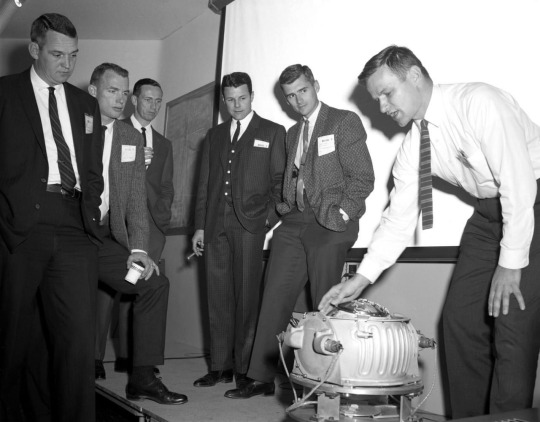

(Credit to NASA)
6 notes
·
View notes
Text
RIP Walter Cunningham, chosen in 1963 as one of "The Fourteen" and was LMP on Apollo 7. He spent a total of 10 days 20 hrs and 8 mins aboard the first manned Apollo mission to launch successfully in 1967.

Source: Wikipedia
Credit: NASA
0 notes
Text
Cancelled Flights: Apollo 2 (AS-205) (Part 1)

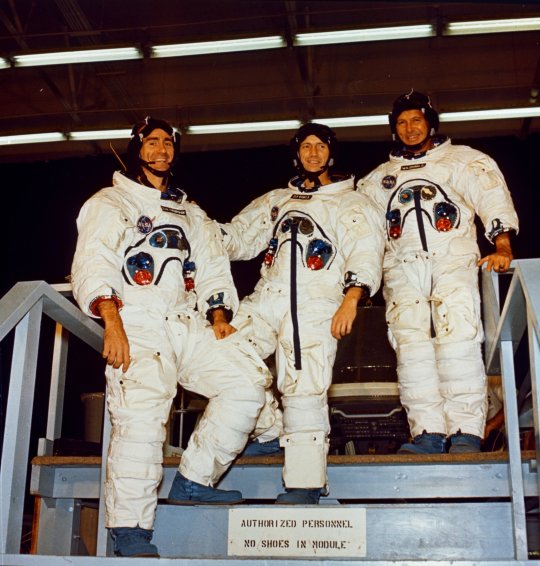
Commander: Walter Marty, Jr. "Wally" Schirra
CM Pilot: Donn Fulton Eisele
LM Pilot: Ronnie Walter "Walt" Cunningham
Planned Launch: April 1967
Vehicle: Saturn IB (SA-205), CSM-014
T"his was planned as the second manned flight of the Apollo spacecraft. This flight was finally seen as unnecessary; the decision to cancel it came on November 16 and was officially announced on December 22, 1966. Flew later as Apollo 7.
Planned second solo flight test of the Block I Apollo CSM on a Saturn IB. Cancelled after the Apollo 204 fire.
This flight was referred to by everyone outside of the astronaut office as AS-205 or CSM-014. This flight was finally seen as unnecessary; the decision to cancel it came on November 16 and was officially announced on December 22, 1966; the Schirra crew instead became, briefly, the backup crew to Apollo 1 (replacing the original backup crew of McDivitt, Scott, Schweickart). After the Apollo 1 fire on January 27, 1967, the Schirra crew was assigned to Apollo 7, the first manned flight test of the new Block II Apollo CSM-101."
-Information from Astronautix.com: link
source
NASA ID: 68-HC-225
#Apollo 2#AS-205#CSM-014#Apollo CSM Block I#Saturn IB#SA-205#Rocket#NASA#Apollo Program#C-type Mission#Cancelled#April#1967#my post
19 notes
·
View notes
Text
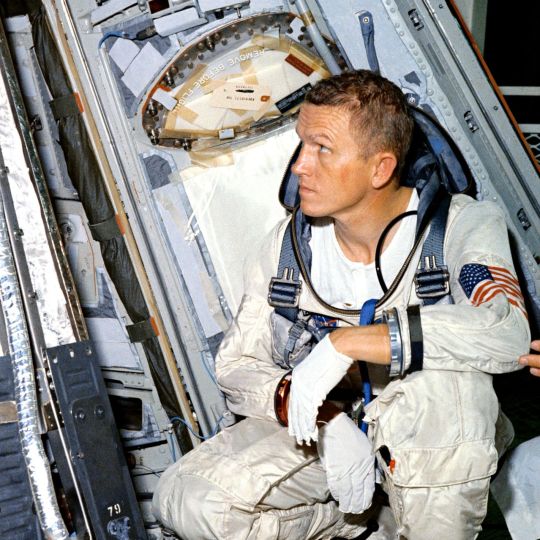
On Christmas Eve 1968, as commander of Apollo 8 – the first manned lunar orbital mission – Frank Borman, who has died aged 95, came out with words that, alongside Neil Armstrong’s “giant leap for mankind”, from Apollo 11 in 1969, and Jack Swigert and Jim Lovell’s “OK, Houston, we’ve had a problem”, from Apollo 13 in 1970, defined an era.
In that moment before the moon programme became mundane, when astronauts were prime time, Apollo 8’s broadcast ended with the crew – Bill Anders, Lovell and Borman – reading the story of Earth’s creation as written in the book of Genesis.
It was Borman’s conclusion, “Good night, good luck, a merry Christmas and God bless all of you, all of you on the good Earth”, that clinched it. For Gene Kranz, Nasa’s chief of flight control operations in Houston, the phrase was “literally magic. It made you prickly. You could feel the hair on your arms rising, and the emotion was just unbelievable.”
Thus, for some, the traumatic 1968 of the ongoing Vietnam war, the assassinations of Martin Luther King and Robert Kennedy, and the crushing of Czechoslovakia, had been transcended. From a distance – around 238,855 miles – it was still, apparently, the good Earth.
Around two years earlier, Nasa had been in crisis. On 27 January 1967, Gus Grissom, Ed White and Roger Chaffee had been incinerated on Apollo 1 during a test launch. Borman was appointed to the Nasa board which, that April, reported on the fire, slamming Nasa management and North American Aviation for its “ignorance, sloth and carelessness”.
Borman was then sent to North American’s plant in Downey, California – where drunkenness had been rife – to scrutinise command module redesign. “Borman set them straight,” wrote the second man on the moon, Buzz Aldrin, in Men from Earth (1989). “His shoot-from-the-hip management style – some called it bullying – worked.”
The Mercury programme had put astronauts in space. Gemini – to which Borman had been recruited in 1962 – had honed the business of Apollo: to fulfil President John F Kennedy’s goal of a manned moon landing by the end of the decade. In December 1965, Borman and Lovell had made their space debut with a record 14 days of orbit on Gemini 7, and also made a rendezvous with Gemini 6.
In the wake of the 1967 tragedy there were three unmanned Apollo launches, with mixed results. But in September 1968 the unmanned Soviet Zond 5’s orbit of the moon triggered alarm in the US. The Soviets had launched Sputnik, and the space age, in 1957. The first man in space, Yuri Gagarin, had orbited Earth in April 1961. That, along with the furore around the Bay of Pigs fiasco, had helped propel JFK into making his rash pledge in May 1961.
Seven years on, in autumn 1968, Nasa and the CIA were asking whether history was going to repeat itself. Would a Russian be first around the moon? That October, the Apollo 7 astronauts, Wally Schirra, Walter Cunningham and Donn Eisele, spent a successful, albeit cold-ridden and fractious, 10 days in orbit around the Earth. There were rows with ground control. None of those three would get another mission.
Nasa needed a breakthrough. Rather than the next planned Earth orbit, Apollo 8 was to be sent to the moon and, after the astronaut Jim McDivitt turned down the offer, Borman got the job. On 21 December, following a morale-boosting visit from the aviator Charles Lindbergh, Borman, Lovell and Anders blasted off.
Borman’s greatest fear, wrote Andrew Chaikin in A Man on the Moon (1994), was that the moon mission would be aborted and Apollo 8 would be confined to orbiting the Earth. It did not happen, but en route Borman was afflicted by vomiting and diarrhoea, the detrital consequences of which floated on, to be trapped by paper towels. The three men orbited the moon 10 times in 20 hours, descended to 69 miles above the rock’s surface, and were the first to witness the far side of what Borman called “a great expanse of nothing”.
It was on the fourth orbit that Borman spotted the Earth rising from behind the moon – an image that Anders captured on colour film and became known as Earthrise. “Oh my God! Look at the picture over there. Here’s the Earth coming up,” Borman is recorded shouting in a transcript.
Born in Gary, Indiana, Frank was the son of Edwin Borman, who ran an Oldsmobile dealership, and Marjorie (nee Pearce). The family moved to Tucson, Arizona, where his mother opened a boarding house, and Frank went to the local high school. He first flew as a teenager, in 1943. Seven years later he graduated from West Point Military Academy in New York state.
From 1950 Borman flew F-84 fighter-bombers with the US Air Force. A perforated ear drum denied him Korean war combat experience. In 1957 he gained a master’s in aeronautical engineering from the California Institute of Technology and became an assistant professor of thermodynamics and fluid mechanics at West Point.
Three years later he graduated from the Aerospace Research Pilot School at Edwards air force base in California. There, his aircraft included the controversial Mach 2 Lockheed F-104 Starfighter. It was in 1962 that, alongside Armstrong, Lovell and others, he became one of Nasa’s Gemini programme “New Nine”. Apollo 8 proved what had been evident to insiders for many years: that the US had won the space race. Borman, Anders and Lovell became Time magazine’s 1968 men of the year.
Having achieved the rank of colonel in the mid-1960s, Borman retired from the USAF and space flight and, after a sojourn at Harvard Business School, joined Eastern Air Lines. By 1975 he was Eastern’s CEO and a year later became chairman. But by the late 70s competition was intensifying, labour relations were deteriorating and Borman – never a diplomat – was in the firing line. He quit the company in 1986 when it was taken over by a corporate raider, and Eastern collapsed five years later.
He and his wife, Susan (nee Bugbee), whom he had married in 1950, moved to New Mexico, where he remained involved in business interests. They later settled in Billings, Montana, where he had a cattle ranch and rebuilt vintage aircraft. A supporter of Richard Nixon and both George Bushes, Borman was a man of brisk views. Among the many targets of his ire were the sound barrier-breaking pilot Chuck Yeager, the Democratic party presidential candidate Michael Dukakis and the scientist Carl Sagan.
He received many honours, including the Congressional Space Medal of Honor in 1978, and published his autobiography, Countdown, in 1988.
Susan died in 2021. His sons, Frederick and Edwin, four grandchildren and six great-grandchildren survive him.
🔔 Frank Frederick Borman II, astronaut, born 14 March 1928; died 7 November 2023
Daily inspiration. Discover more photos at Just for Books…?
12 notes
·
View notes
Photo

August 1968, Apollo 7 water egress training
During the Gemini-Apollo era, NASA modified a World War II Landing Craft Utility vessel in order to train astronauts in post-splash-down ocean recovery operations and water egress from their command modules.
50 years ago, in 1972, NASA transferred the MV Retriever to the Virginia Institute of Marine Science.
Photo shows John Jack Swigert, Apollo 7 support crew astronaut, Walter Schirra Apollo 7 commander and Donn Eisele Apollo 7 CMP Command Module Pilot onboard the MV Retriever.
Note both Swigert and Schirra wore their personal Rolex GMT-master 1675 Pepsi bezel pilot watch on a steel oyster bracelet. The best watch choice to be worn during water egress ops in the Gulf of Mexico!
(Photo: NASA/LIFE)
#Aviator#Apollo#Astronaut#Rolex#NASA#GMT-master#1675#Pepsi#Navy#USAF#Retriever#SAR#Water egress#Gulf Mexico#spaceflight#MoonwatchUniverse#1968#montres#military#uhren#horloges#wrist watch#Oyster bracelet#Zulu time#SWFG
9 notes
·
View notes
Link
The new year of 1969 dawned with optimism that NASA would meet President John F. Kennedy’s goal of landing a man on the Moon and returning him safely to the Earth. The previous year saw four Apollo missions, two uncrewed and two carrying three astronauts each, test different components of the lunar landing architecture, culminating with Apollo 8’s December flight around the Moon. Challenges remaining for the new year included testing the Lunar Module (LM) with a crew, first in Earth orbit, and then in lunar orbit, a flight that served as a dress rehearsal for the Moon landing that could take place on the following mission. With flights occurring every two months, engineers at NASA’s Kennedy Space Center (KSC) in Florida processed three spacecraft and launch vehicles in parallel. Recovering from the fire Left: The Apollo 1 crew of Virgil I. “Gus” Grissom, left, Edward H. White, and Roger B. Chaffee. Middle left: Liftoff of the first Saturn V on the Apollo 4 mission. Middle right: The Lunar Module for the Apollo 5 mission. Right: Recovery of the Apollo 6 Command Module. The years 1967 and 1968 proved turbulent for the world. For NASA, the focus remained on recovering from the tragic Apollo 1 fire in time to meet President Kennedy’s fast approaching end of the decade deadline. The fire resulted in a thorough redesign of the Command Module (CM) to reduce flammability risks and to include an easy to open hatch. Engineers also removed flammable materials from the Lunar Module (LM). In November 1967, the first flight of the Saturn V carried Apollo 4 on a nine-hour uncrewed mission to test the CM’s heat shield. Apollo 5 in January 1968 completed an uncrewed test of the LM so successful that NASA decided to cancel a second test. Although fraught with problems, the April 1968 flight of Apollo 6 tested the CM heat shield once again. Managers believed that engineers could solve the problems encountered during this mission and declared that the next Saturn V would carry a crew. Apollo 7 and 8 Left: Apollo 7 astronauts Walter M. Schirra, left, Donn F. Eisele, and R. Walter Cunningham on the recovery ship USS Essex following their 11-day mission. Right: The famous Earthrise photograph from Apollo 8. By October 1968, thorough ground testing of the Apollo spacecraft enabled the first crewed mission since the fire. Apollo 7 astronauts Walter M. Schirra, Donn F. Eisele, and R. Walter Cunningham successfully completed the 11-day test flight, achieving all mission objectives. In August, with LM development running behind schedule, senior NASA managers began discussions of sending Apollo 8 on a circumlunar flight, pending the outcome of Apollo 7. With that hurdle successfully cleared, astronauts Frank Borman, James A. Lovell, and William A. Anders orbited the Moon 10 times during Christmas 1968, taking a giant leap toward achieving the Moon landing. Left: At the White House, Apollo 8 astronauts Frank Borman, James A. Lovell, and William A. Anders present a copy of the Earthrise photograph to President Lyndon B. Johnson. Middle: Accompanied by Vice President Hubert H. Humphrey, Borman, Lovell, and Anders take a motorcade from the White House to the Capitol. Right: Borman, left, Lovell, and Anders address a joint meeting of Congress. With their space missions completed, the Apollo 7 and 8 crews remained busy with events celebrating their successes. On Jan. 3, 1969, TIME magazine named Apollo 8 astronauts Borman, Lovell, and Anders their Men of the Year for 1968. Kicking off a whirlwind of events, on Jan. 9, outgoing President Lyndon B. Johnson welcomed them to the White House, where he presented them with NASA Distinguished Service Medals. They in turn presented him with a copy of the famous Earthrise photograph. Accompanied by Vice President Hubert H. Humphrey, Borman, Lovell, and Anders rode in a motorcade down Pennsylvania Avenue to the Capitol where the astronauts addressed a joint meeting of Congress. From there, they proceeded to the State Department for a press conference, their day ending with a dinner in their honor at the Smithsonian Institution. Left: Apollo 8 astronauts James A. Lovell, left, Frank Borman, and William A. Anders wave to the crowds assembled along their parade route in New York City. Middle: Borman, Lovell, and Anders address a crowd at Newark airport. Right: In Miami’s Orange Bowl Lovell, left, Borman, and Anders lead the fans in the Pledge of Allegiance at Super Bowl III. On Jan. 10, New York City held a tickertape parade for Borman, Lovell, and Anders. Mayor John V. Lindsay presented them with Medals of the City of New York, after which they attended a luncheon at Lincoln Center, a reception at the United Nations, and dinner at the Waldorf-Astoria Hotel. The next day, in 15-degree weather, they spoke to a crowd of about 1,500 people at Newark Airport before boarding a plane for much warmer Miami, where on Jan. 12 they attended Super Bowl III, and led the Orange Bowl crowd in reciting the Pledge of Allegiance. Left: In Houston, Apollo 8 astronauts William A. Anders, left, Frank Borman, and James A. Lovell present an Earthrise photograph and flags of Texas to Governor John B. Connally, far right, and Mayor Louie Welch, hidden behind the photograph. Middle: Borman and his family in the parade through downtown Houston, with Lovell and Anders and their families following behind. Right: Lovell, Borman, and Anders wave to the crowds in the parade in Chicago. A crowd estimated at about 250,000 welcomed Borman, Lovell, and Anders home to Houston on Jan. 13. In a ceremony outside the Albert Thomas Convention Center, Mayor Louie Welch presented them with bronze medals for heroism, and the astronauts presented Welch and Texas Governor John B. Connally with plaques bearing Texas flags they had flown to the Moon as well as a framed copy of the Earthrise photograph. The astronauts took part in the largest parade in the city’s history. The next day, the city of Chicago welcomed Borman, Lovell, and Anders. An estimated 1.5 million people cheered them on their parade route to a reception where they received honors from city council. Left: The Apollo 7 Command Module and a Lunar Module mockup on a float in President Richard M. Nixon’s inauguration parade; Apollo 7 astronauts Walter M. Schirra, R. Walter Cunningham, and Donn F. Eisele preceded the float in an open-air limousine. Image credit: courtesy Richard Nixon Library. Right: Apollo 8 astronauts Frank Borman, left, James A. Lovell, and William A. Anders with President Nixon at the White House. On Jan. 20, Apollo 7 astronauts Schirra, Eisele, and Cunningham rode in President Richard M. Nixon’s inauguration parade in Washington, D.C. Their spacecraft and a LM mockup rode on a float behind them. Ten days later, the new President invited Apollo 8 astronauts Borman, Lovell, and Anders to the White House where he announced that Borman and his family would embark on an 18-day goodwill tour of eight European nations, starting on Feb. 2. Apollo 9 The LM remained the one component of the lunar landing architecture not yet tested by astronauts in space. That task fell to James A. McDivitt, David R. Scott, and Russell L. Schweickart, the crew of Apollo 9. They and their backups Charles “Pete” Conrad, Richard F. Gordon, and Alan L. Bean spent many hours in the LM simulators and training for the spacewalk component of the mission. Left: In preparation for the Apollo 9 spacewalk, astronaut Russell L. Schweickart tests the Portable Life Support System backpack in an altitude chamber at the Manned Spacecraft Center (MSC), now NASA’s Johnson Space Center in Houston. Middle: Schweickart trains for his spacewalk in MSC’s Water Immersion Facility. Right: Apollo 9 backup astronauts Richard F. Gordon, left, and Alan L. Bean train for the spacewalk in the KC-135 zero-gravity aircraft. Apollo 9’s 10-day mission would take place in the relative safety of low Earth orbit. After docking with the LM, the crew’s first major task involved the first spacewalk of the Apollo program and the only in-space test of the new A7L spacesuit before the Moon landing. McDivitt and Schweickart planned to enter the LM, leaving Scott in the CM. Schweickart and Scott would each perform a spacewalk from their respective spacecraft. Scott would only stand in the open CM hatch while Schweickart would exit via the LM’s front hatch onto its porch, translate over to the CM using handrails, retrieve materials samples mounted on the spacecraft’s exterior and return back to the LM, spending two hours outside. This spacewalk tested the ability of crews to transfer through open space, in case a malfunction with the tunnel or hatches between the two spacecraft prevented an internal transfer. The day after the spacewalk, McDivitt and Schweickart planned to undock the LM, leaving Scott in the CM, fly it up to 100 miles away, testing its descent and ascent stages before returning to Scott in the CM who would perform the rendezvous and docking. At NASA’s Kennedy Space Center in Florida, three views of the Apollo 9 rollout from the Vehicle Assembly Building to Launch Pad 39A. The first of the three vehicles in processing flow at KSC, Apollo 9 rolled out from High Bay 3 of the Vehicle Assembly Building (VAB) to Launch Pad 39A on Jan. 3, just 13 days after Apollo 8 launched from the same facility, causing relatively minor damage. Stages of the Apollo 9 Saturn V had arrived at KSC during the spring and summer of 1968, the LM arrived in June and the Command and Service Modules (CSM) in October. Workers completed stacking of the Saturn V in October, adding the Apollo spacecraft in early December. On Jan. 8, NASA announced Feb. 28, 1969, as the planned launch date for Apollo 9. Left: Apollo 9 astronauts James A. McDivitt, front, David R. Scott, and Russell L. Schweickart depart crew quarters for the ride to Launch Pad 39A for emergency escape training. Middle: Scott, left, Schweickart, and McDivitt in the White Room during the pad emergency escape drill. Right: Scott, left, McDivitt, and Schweickart pose with their mission patch following a press conference at Grumman Aircraft and Engineering Corporation in Bethpage, New York. Workers at the pad immediately began to prepare the vehicle for flight, including software integration tests with the Mission Control Center at the Manned Spacecraft Center (MSC), now NASA’s Johnson Space Center in Houston. On Jan. 15, the prime and backup crews conducted emergency egress training from their spacecraft at Launch Pad 39A. Launch controllers at KSC successfully completed the Flight Readiness Test, the final major overall test of the vehicle’s systems, between Jan. 19 and 22. During a Jan. 25 press conference at the Grumman Aircraft and Engineering Corporation in Bethpage, New York, manufacturer of the LM, the Apollo 9 astronauts provided reporters with an overview of their mission. Apollo 10 Assuming Apollo 9 met its objectives and the LM proved space worthy in Earth orbit, in May Apollo 10 would repeat many of those tests in lunar orbit, including flying to within nine miles of the Moon’s surface. Left: Apollo 10 backup astronauts L. Gordon Cooper, front, and Edgar D. Mitchell arrive in the vacuum chamber in the Manned Spacecraft Operations Building (MSOB) at NASA’s Kennedy Space Center in Florida for a Lunar Module (LM) altitude test. Middle: Engineers in the MSOB conduct a docking test between the LM and the Command Module (CM) docking test. Right: Engineers prepare the CM for an altitude test. In November 1968, just six months before the planned launch date, NASA officially named the Apollo 10 crew. The prime crew consisted of Thomas P. Stafford, John W. Young, and Eugene A. Cernan. All had flown Gemini missions and had recently served as the Apollo 7 backup crew. L. Gordon Cooper, Donn F. Eisele, and Edgar D. Mitchell served as their backups. Left: In High Bay 2 of the Vehicle Assembly Building at NASA’s Kennedy Space Center (KSC) in Florida, the three stages of the Apollo 10 Saturn V await the arrival of the spacecraft. Middle left: In KSC’s Manned Spacecraft Operations Building (MSOB), workers remove the Lunar Module (LM) from an altitude chamber. Middle right: Workers in the MSOB lower the LM onto the base of the Spacecraft LM Adapter (SLA). Right: After installing the main engine bell, workers lift the Command and Service Module for mating with the SLA. In the VAB’s High Bay 2, workers had completed stacking the Apollo 10 Saturn V’s three stages by the final days of 1968, while their colleagues prepared to roll Apollo 9’s rocket to the pad a few days later. In the nearby Manned Spacecraft Operations Building (MSOB), prime and backup crews completed altitude tests of the LM in December and workers conducted a docking test between the LM and the CM. On Jan. 16, Stafford, Young, and Cernan completed their altitude test of the CM, followed by Cooper, Eisele, and Mitchell the next day. Workers removed the spacecraft from the altitude chamber in preparation for its rollover to the VAB in early February for stacking onto the rocket. Apollo 11 Assuming Apollo 9 and 10 accomplished their objectives, Apollo 11 would attempt the first Moon landing in July. Should Apollo 11 not succeed, NASA would try again with Apollo 12 in September and even Apollo 13 in November or December. Spacecraft and rocket manufacturers continued building components to meet that aggressive schedule. Apollo 11 crew of Edwin E. “Buzz” Aldrin, left, Neil A. Armstrong, and Michael Collins. On Jan. 9, a mere six months before the planned launch date, NASA formally announced the Apollo 11 crew, the second all-veteran three-person crew after Apollo 10 – and the last all-veteran crew until STS-26 in 1988. The next day, NASA introduced the Apollo 11 crew during a press conference at MSC. The prime crew consisted of Neil A. Armstrong, Michael Collins, and Edwin E. “Buzz” Aldrin. Each astronaut had flown one Gemini mission. Armstrong and Aldrin had served on the backup crew for Apollo 8 while Collins was initially a member of the prime Apollo 8 crew until a bone spur in his neck requiring surgery sidelined him. He fully recovered from the operation, and NASA included him in the Apollo 11 crew. The Apollo 11 backup crew consisted of James A. Lovell, William A. Anders, and Fred W. Haise. Lovell and Anders had just completed the Apollo 8 lunar orbit mission with Haise a backup crew member on that flight. When Anders announced that he would retire from NASA in August 1969 to join the National Space Council, Thomas K. “Ken” Mattingly began training in parallel with Anders in case the mission slipped past that date. Left: The Lunar Module for Apollo 11 arrives at NASA’s Kennedy Space Center (KSC) in Florida. Middle: The Apollo 11 Command Module, left, and Service Module, in KSC’s Manned Spacecraft Operations Building shortly after their arrival. Right: The S-IVB third stage for Apollo 11’s Saturn V rocket arrives at KSC. Hardware began to arrive at KSC for Apollo 11. With the Apollo 10 CSM still undergoing testing in the MSOB, the Apollo 11 LM’s ascent and descent stages arrived Jan. 8 and 12, respectively, followed by the CM and SM on Jan. 23. Workers in the MSOB prepared the spacecraft for vacuum chamber testing. The Saturn V’s S-IVB third stage arrived on Jan. 19. Workers trucked it to the VAB where it awaited the arrival of the first two stages, scheduled for February. Lunar Receiving Laboratory Left: Schematic of the Lunar Receiving Laboratory (LRL) showing its major functional areas. Right: A mockup Command Module in the spacecraft storage area, part of the Crew Reception Area, in the LRL. With the Moon landing possibly just six months away, NASA continued to prepare key facilities designed to receive astronauts returning from the Moon. The 83,000-square-foot Lunar Receiving Laboratory (LRL), residing in MSC’s Building 37, was specially designed and built to isolate the astronauts, their spacecraft, and lunar samples to prevent back-contamination of the Earth by any possible lunar micro-organisms, and to maintain the lunar samples in as pristine a condition as possible. The building was completed in 1967, and over the next year, workers outfitted its laboratories and other facilities. A 10-day simulation in the facility in November 1968 found some deficiencies that NASA addressed promptly. On Jan. 23, 1969, workers brought a mockup Apollo CM into the LRL’s spacecraft storage area for fit checks. Left: Workers at the Norfolk Naval Air Station in Virginia hoist the Mobile Quarantine facility (MQF) onto the USS Guadalcanal. Middle: The flexible tunnel set up between the MQF and a mockup Command Module. Right: Workers in Norfolk load the MQF onto a C-141 cargo plane for the return flight to Ellington Air Force Base in Houston. An integral component of the back-contamination prevention process was the Mobile Quarantine Facility (MQF). Following lunar landing missions, the MQF housed astronauts and support personnel from their arrival onboard the prime recovery ship shortly after splashdown through transport to the LRL. Under contract to NASA, Melpar, Inc., of Falls Church, Virginia, converted four 35-foot Airstream trailers into MQFs, delivering the first unit in March 1968 and the last three in the spring of 1969. The first unit was used extensively for testing, with lessons learned incorporated into the later models. On Jan. 21, 1969, workers loaded the MQF aboard a U.S. Air Force C-141 cargo plane at Ellington Air Force Base near MSC to transport it to the Norfolk Naval Air Station in Virginia. Six recovery specialists from MSC spent 10 days inside the MQF, first aboard the helicopter landing-platform USS Guadalcanal (LPH-7), including attaching a flexible tunnel to a boilerplate Apollo CM, and then aboard the destroyer USS Fox (DLG-33). The overall exercise, successfully completed on Feb. 3, tested all MQF systems aboard ships and aircraft to simulate recovery operations after a lunar landing mission. To be continued … With special thanks to Ed Hengeveld for imagery expertise. News from around the world in January 1969: Jan. 7 – Congress doubles the President’s salary from $100,000 to $200,000 a year. Jan. 9 – First test flight of the Franco-British Concorde supersonic jetliner in Bristol, U.K. Jan. 12 – In Super Bowl III, played in Miami’s Orange Bowl, the New York Jets beat the Baltimore Colts 16 to 7. Jan. 16 – The Soviet Union conducts the first docking between two crewed spacecraft and the first crew transfer by spacewalking cosmonauts during the Soyuz 4 and 5 missions. Jan. 20 – Richard M. Nixon inaugurated as the 37th U.S. President. Jan. 30 – The Beatles perform their last live gig, a 42-minute concert on the rooftop of Apple Corps Headquarters in London. Explore More 8 min read 50 Years Ago: Skylab 4 Astronauts Begin Record-Breaking Third Month in Space Article 1 week ago 6 min read 10 Years Ago: The First Operational Cygnus Cargo Mission to the Space Station Article 1 week ago 5 min read NASA’s Deep Space Network Turns 60 and Prepares for the Future Article 4 weeks ago
1 note
·
View note
Text
Birthdays 6.23
Beer Birthdays
Henry Foss (1817)
Joseph Seelinger (1863)
Brian Yaeger (1974)
Angelo M. De leso II (1976)
Five Favorite Birthdays
Richard Bach; writer (1927)
Bob Fosse; choreographer, film director (1927)
Alfred Kinsey; behavioral scientist, sexologist (1894)
KT Tunstall; Scottish singer, songwriter (1975)
Alan Turing; English mathematician and computer scientist (1912)
Famous Birthdays
Anna Akhmatova, Ukrainian-Russian poet and author (1889)
Jean Anouilh; playwright (1910)
Paul Arthurs; English guitarist (1965)
Selma Blair; actor (1972)
Frank Bolle; comic-book artist and illustrator (1924)
Bryan Brown; actor (1947)
Scott Burton; sculptor (1939)
Ptolemy Caesarion of Egypt; son of Julius Caesar & Cleopatra (47 B.C.E.)
June Carter Cash; country singer (1929)
Irvin S. Cobb; writer (1876)
Edward VIII; UK King (1894)
Donn F. Eisele; pilot, and astronaut (1930)
Albert Giraud; Belgian poet (1860)
Magda Herzberger; Romanian author, poet and composer (1926)
Robert Hunter; singer-songwriter and guitarist (1942)
James Levine; pianist and conductor (1943)
Frances McDormand; actor (1957)
James Meade; English economist (1907)
Jason Mraz; singer-songwriter(1977)
David Ogilvy; advertiser (1911)
Arnaldo Pomodoro; Italian sculptor (1926)
Melissa Rauch; actress (1980)
Stephanie Renee; adult actress (1984)
Wilma Rudolph; olympic sprinter (1940)
Michael Shaara; author (1928)
Ted Shackelford; actor (1946)
Stuart Sutcliffe; Scottish artist, Beatles 1st bassist (1940)
Monica Sweetheart; adult actress (1981)
Clarence Thomas; conservative U.S. Supreme Court justice (1948)
Anthony Thwaite; English poet (1930)
LaDainian Tomlinson; San Diego Chargers RB (1979)
Joss Whedon; writer, film director (1964)
Duane Whitaker; actor (1959)
0 notes
Text
A Look at the Cost of NASA Spaceflight Missions
A Look at the Cost of NASA Spaceflight Missions
America’s history of lunar exploration is highlighted by Project Apollo, a series of manned space flight expeditions to the moon from 1960 to 1973. The total cost of the project was nearly $26 billion at the time, or nearly $260 billion when adjusted for inflation. The initial figure is boosted to $28 billion, or $280 billion today, when accounting for Project Gemini and the robotic lunar program, both of which were critical to the success of Project Apollo. As an organization, NASA spent just under $49.5 billion, or $482 billion adjusted, over the same time period.
Individuals may be surprised to discover that the cost of the spacecraft used was only a fraction of the total project cost. The Apollo Project’s 17 spacecraft, which were launched from 1961 to 1972, cost $8.1 billion at the time, or $81 billion today. By comparison, launch vehicles cost $9.4 billion, or nearly $100 billion adjusted. Additional expenses ranged from $3.1 billion in development and operations to $5.2 billion in ground facilities and salaries.
Apollo 7, the first fully crewed flight to come out of project Apollo, left earth on October 11, 1968. It was severely underfunded compared to future launches, with less than 50 percent of the budget allotted to the median cost of Apollo 8 through Apollo 17. Astronauts Walter M. Schirra, Donn F. Eisele, and R. Walter Cunningham became the first humans to take part in a television broadcast from space. The successful mission gave NASA the confidence needed to put humans into lunar orbit with Apollo 8.
The Apollo 8 mission saw the budget increase from $145 million to $310 million. The cost of launching Apollo missions gradually increased over the years, with Apollo 10 costing $350 million. Interestingly, the budget increased by only $5 million from Apollo 10 to Apollo 11, despite the latter involving the first NASA astronauts to touch down on and explore the lunar surface.
However, with a depth of new data to explore and pursue, the Apollo Project began to increase its spending, jumping to $375 million for Apollo 12 and Apollo 13. NASA spending significantly increased following incidents that occurred during the Apollo 13 mission.
Apollo 13 was scheduled as America’s third consecutive moon-landing mission. However, an explosion early in the mission prevented the crew from ever reaching the lunar surface, and nearly resulted in catastrophe for Project Apollo. Fortunately, the crew successfully sheltered in the ship’s lunar module and made a harrowing but ultimately successful return to earth.
The launch of Apollo 14 was delayed by a year following the events of Apollo 13. Heightened scrutiny regarding NASA safety features and protocols resulted in expenditures increasing by $25 million for Apollo 14, and an additional $45 to $50 million on the three remaining Project Apollo launches.
After the Apollo 17 mission, NASA suspended flights to the moon, primarily citing the exorbitant cost. NASA has announced intentions to return to the moon, first with a lunar loop in 2024, followed by a lunar landing in 2025. Estimates for the entire Artemis program, from its conception in 2012 through the 2025 launch, are $93 billion, with each individual launch costing about $4.1 billion.
via Blogger https://ift.tt/EKkbsiD
May 16, 2023 at 06:59AM
0 notes
Text
Apollo 7 astronaut Cunningham dies at age 90
Former U.S. astronaut Walter Cunningham, who flew to space aboard Apollo 7 in 1968 on the inaugural crewed Apollo mission that paved the way for the first human moon landing nine months later, died on Tuesday at age 90, NASA said.
Former U.S. astronaut Walter Cunningham, who flew to space aboard Apollo 7 in 1968 on the inaugural crewed Apollo mission that paved the way for the first human moon landing nine months later, died on Tuesday at age 90, NASA said.
Cunningham joined crewmates Walter Schirra and Donn Eisele for the 11-day mission, which was conducted in low-Earth orbit. It was the first human test flight of the…

View On WordPress
0 notes
Text
Former astronaut Cunningham, member of first crewed Apollo flight, dies at age 90
Former astronaut Cunningham, member of first crewed Apollo flight, dies at age 90
WASHINGTON— Former U.S. astronaut Walter Cunningham, who flew to space aboard Apollo 7 in 1968 on the inaugural crewed Apollo mission that paved the way for the first human moon landing nine months later, died on Tuesday at age 90, NASA said.
Cunningham joined crewmates Walter Schirra and Donn Eisele for the 11-day mission, which was conducted in low-Earth orbit. It was the first human test…
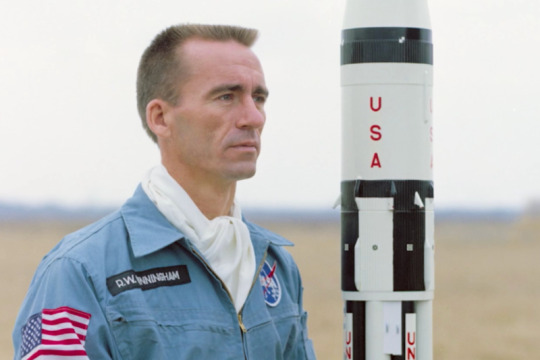
View On WordPress
0 notes
Text
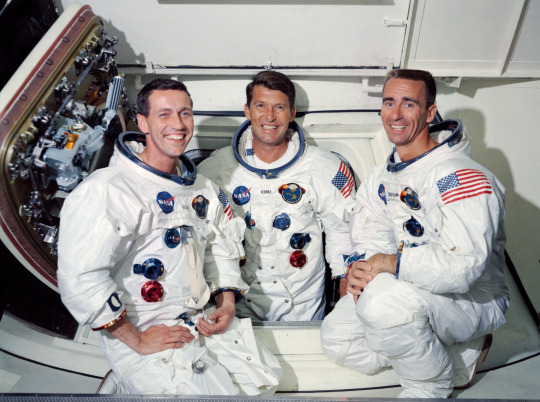

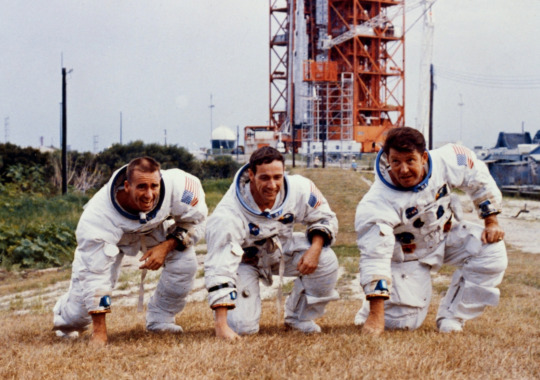
October 11, 1968: Apollo 7 launches into space
Apollo 7 was the first manned Apollo mission and NASA's return to flight following the Apollo 1 disaster in January 1967. It carried a crew of three— Wally Schirra, Donn Eisele, and Walt Cunningham— on an 11-day test of the Apollo spacecraft in low Earth orbit.
Celebrate Apollo 7's 55th anniversary with 10 fun facts about the mission!
14 notes
·
View notes
Text
Bidding farewell to an unsung legend

R.I.P. James A. McDivitt, test pilot and astronaut. He passed away on October 13 and somehow it flew utterly beneath my radar.
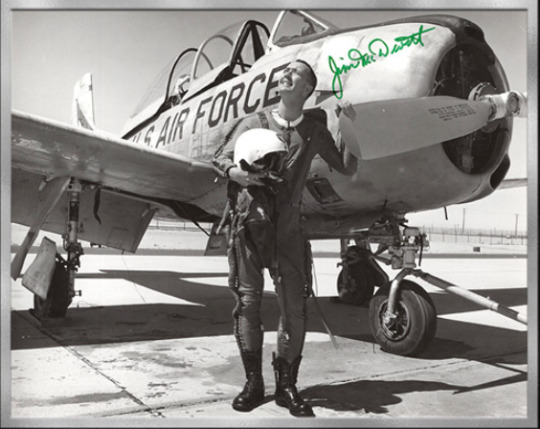
Jim McDivitt was a Korean War combat pilot, and earned a Bachelors in Aeronautical Engineering from University of Michigan, a spot in the USAF Experimental Flight Test Pilot School, and was a member of the inaugural class at the Aerospace Research Pilot School. He had over 2,000 hours in jets (here he is striking a heroic pose with a decidedly not-heroic T-28).

Later Jim was selected as a member of NASA Group 2, known as “the New (or Next) Nine.” They were chosen to augment the Original Seven for the Gemini program and beyond. From lower left, they are Jim Lovell*, Elliot See, Ed White, Neil Armstrong**, Frank Borman*, John Young**, Tom Stafford*, Pete Conrad**, and that's Jim McDivitt front and center.
(*) Six of this group went to the Moon and three (**) of them walked on it; two more died in tragic accidents before getting their chance to go. None of them were Jim McDivitt, so his career is often overlooked.

Thanks to a thing called “the pecking order,” the Mercury Seven were automatically first in line when it came to getting the mission assignments, but with the two-man Gemini program starting up, that meant Chief Astronaut Deke Slayton could assign some of these new guys to fill the right seat while the Mercury veterans commanded the mission. John Young was the first guy from Group 2 to fly, paired with America's second man in space Gus Grissom, for the first crewed Gemini mission: a simple (well, as simple as anything related to spaceflight can be, that is) shakedown flight called Gemini 3.
But Gemini 4 (June 1965) was much more ambitious, and McDivitt was given command, making him the first rookie to command a crew.
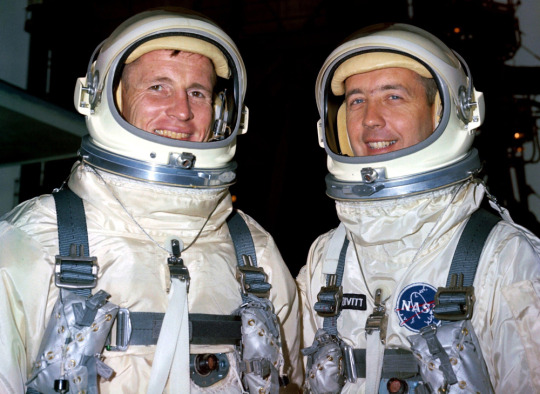
Flying right seat (left, in this photo) was his fellow Group 2 buddy and former University of Michigan schoolmate Ed White. The mission plan was packed; it was going to be four days long— longer than all of America's previous spaceflights put together. They were going to practice celestial navigation with a sextant and attempt a rendezvous with a spent rocket stage. And thanks to cosmonaut Alexei Leonov having become the first man to leave his spacecraft while in orbit earlier that year, a spacewalk was hurriedly added to Gemini 4, too.
This task fell to White, as of course McDivitt would be responsible for flying the spacecraft.

McDivitt's pictures of White during his extravehicular activity (EVA) are among some of the most spectacular in all of NASA's history.
BTW the so-called controversy of Ed White becoming too enamored of the void of space to come back into the spacecraft is bullshit. The comms setup was that the guy outside could only hear the guy inside, not the ground, and they kept stepping on each others’ transmissions.

Next up for Jim would be command of Apollo 8, the first crewed test of the Apollo Lunar Module (LM) in Earth orbit. Along for the ride were Group 3 astronauts Dave Scott, a veteran of Gemini 8, as command module pilot (CMP), and rookie Rusty Schweickart, as LMP.
Apollo 7 (Wally Schirra, Walt Cunningham, Donn Eisele) had successfully tested the CM in Earth orbit in October of 1968. But just as the Soviets had changed the Gemini 4 mission with Leonov's spacewalk, they changed the remaining Apollo schedule with their Zond spacecraft, which was capable of flying around the moon and back. They had one ready to launch, and if successful, they could say “We got there first; that means we won the space race. Ешьте дерьмо, неудачники!” And Apollo 8’s LM was nowhere near ready to fly.
So Deke and the higher-ups at NASA decided to send Apollo 8 to the moon first, by itself, without the LM. Deke didn't want to lose Jim’s crew’s experience with their lander, so he swapped them with the crew of Apollo 9: Frank Borman, Jim Lovell, and Bill Anders, who went on to spend Christmas 1968 in lunar orbit (famously reading from Genesis on Christmas Day).
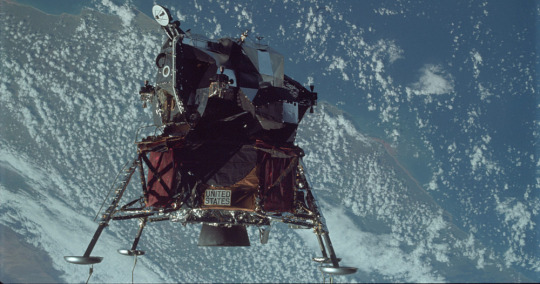
In March of 1969 the CM Gumdrop (Dave Scott thought it looked like a piece of candy when it arrived at the Cape wrapped in cellophane) and LM Spider (well, just look at it!) were launched and tested thoroughly in Earth orbit. When Jim and Rusty flew off in Spider they became the first men to fly a spacecraft which could not land if things went wrong (weight was such an issue that the cabin walls were made of layers so thin that if you dropped a screwdriver it would puncture them, and of course it had no heat shield to get through Earth's atmosphere).
The crew put Spider through its paces; firing the descent engine several times, testing its ability to maneuver with the thrusters, and firing the ascent engine to get back to Dave in Gumdrop. Rusty also did a modified spacewalk to test the lunar EVA suit (sadly, he was spacesick at the beginning of the mission and as a result, never got to fly again).
After retiring from active flight status, Jim served as NASA’s Spacecraft Program Manager for a few years and retired from the Air Force in 1972 with the rank of Brigadier General; he also earned a buttload of Flying Medals, Distinguished Service Medals, and other honors throughout the course of his life.

Jim, Dave, and Rusty reunited in 2019 for the flight's 50th anniversary. With Jim’s passing, the Apollo 8 crew is the last Apollo crew still intact.
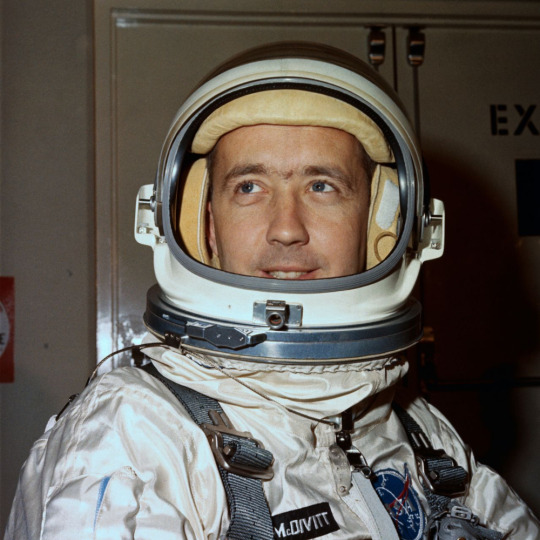
Ad Astra, Jim: June 10 1929 - October 14, 2022
1 note
·
View note
Text

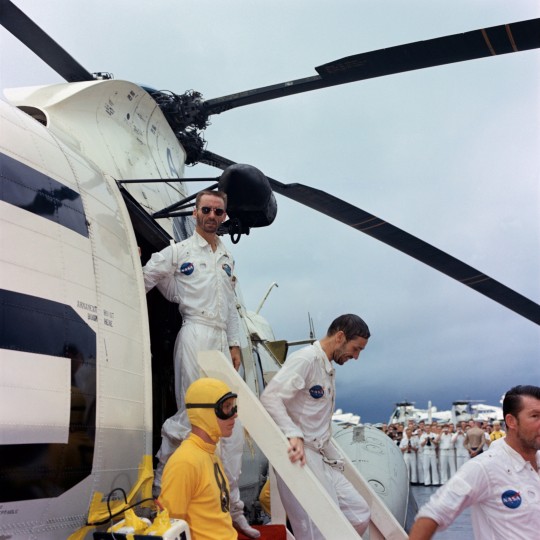

Apollo 7 Astronauts welcomed aboard the USS ESSEX (CV-9). Left to right, are astronauts Walter M. Schirra Jr., commander; Donn F. Eisele, command module pilot; and, Walter Cunningham, lunar module pilot.

Date: October 22, 1968
NASA ID: S68-49698, S68-49735, S68-49744
#Apollo 7#Apollo CSM Block II#CSM-101#NASA#Apollo Program#C-type mission#Recovery#USS ESSEX (CV-9)#USS ESSEX#Essex Class#Aircraft Carrier#Atlantic Ocean#United States Navy#US Navy#Navy#USN#October#1968#my post
27 notes
·
View notes
Note
Headcanons for hanging out with all the Air Force Astros!
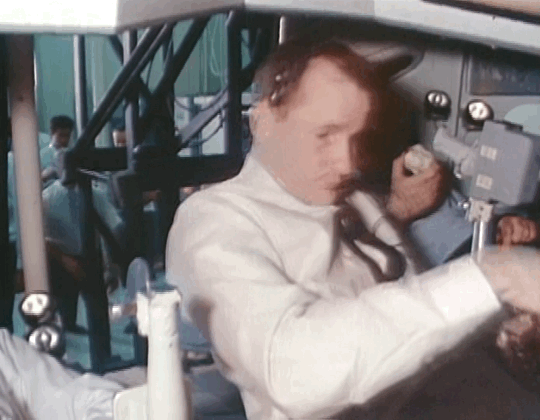
Hanging with the Air Force NASA Astronauts:
Getting asked to a huge Air Force officer function by Ed
His wife had a huge headache that night and couldn't make it
so he wants his best work friend, you, to come with him
the rest of the astros who are going convince you to go
they say that you deserve to have a fun night out
and it honestly doesn't disappoint
so many shenanigans
Ed picks you up in his car for the function
but it's not just you and him
he also promised Charlie and his wife a ride, too
so Charlie and his wife are in the backseat
you and Ed are in the front
Charlie is being a backseat driver
you get to have control of the radio station
lots of pre-game songs
lots of energy
by the time you guys pull up, you're all singing to the top of your lungs
Gus and Betty meet you all at the door
Gus looks like he's literally so ready to go home
until you walk in with Ed
you two make his night instantly better
you talk shop together
the latest planes getting flown into Langley
the upcoming trip to Northrup Grumman
you go to get some punch at the drink table
Donn is already there and a little buzzed tbh
he "secretly" tells you that he maybe spiked the punch
so you grab some water instead
you see Jim Irwin and Al Worden chatting in the corner
y'all laugh at how formal everyone is trying to act
except for maybe Donn
not much dancing takes place
but it's nice to just stand and chat with the astros you don't get to see very often
Ed takes you home after
he thanks you for being his stand-in date
he says that you were a lot of fun :)
8 notes
·
View notes
